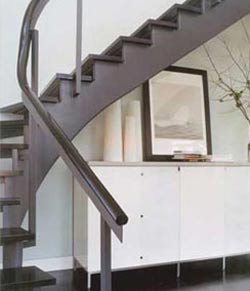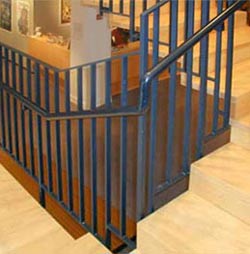|
Hot
Rolled Steel is a method by which red-hot billets of steel are squashed
between different shaped rollers to produce pre-formed steel products
like I-Beams, C-Channels, Angles, etc. It is also available in tubes,
pipes, bars, sheets, and thick plates. It's the most prevalent, least
expensive steel available. It's the "structural" steel that skyscrapers
are made from. It's the "mechanical" steel of square tubes and angles
that simple structures are made of. Because it's produced hot and cools
after it's done, the forms in which it's available are less fine and
less precise than it's sister, Cold Finished Steel. The vast use of Hot
Rolled Steels normally is not seen - it's behind the walls and under
the floors and in back of the veneered panels. But occasionally it's
used in a visible piece. Such is the case in the photos below.
Hot Rolled Steel's identifying surface finish is the
blue-grey oxide scale that covers the naturally-grey color of steel
metal. It can be welded, shaped, drilled, formed, forged, and is in
every way a versatile and affordable material. You just have to put up
with the rough finish and imprecise dimensions.
|
This
is an image of the different shapes
and forms commonly available in Hot Rolled Steel. Click on the image to
go to our sister-site we've built specifically for architects and
designers who want to use metals in their designs. You'll be able to
see much more information on
the stock Hot Rolled Steel materials palette regularly available in the USA.
|
Below are some images of Hot Rolled Steel work that we've built.

|
This staircase stringer is built from Hot Rolled Steel structural
elements. The characteristic round corners are evident in the stringer.
The balusters and rail cap support on the other hand are made from Cold
Finished Steel which has sharp corners and a fine finish.
|

|
This is another staircase made entirely from Hot Rolled Steel elements
on which fine wood treads have been placed making a striking contrast.
|
|
|